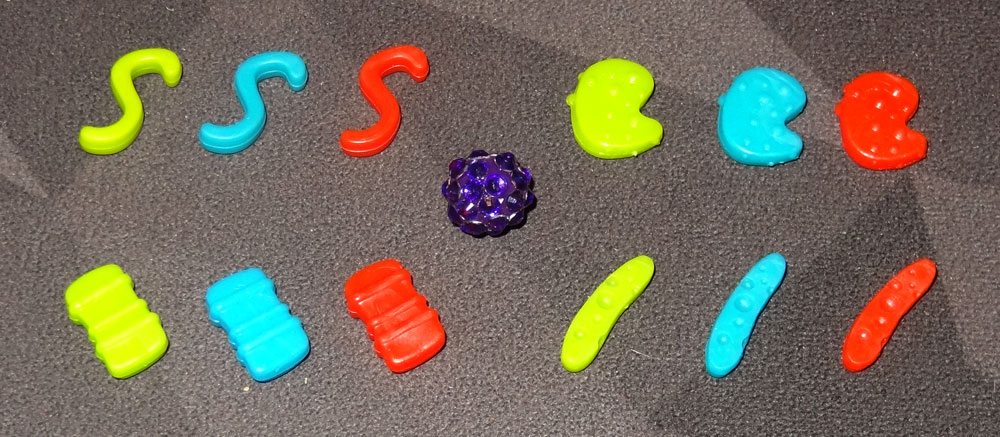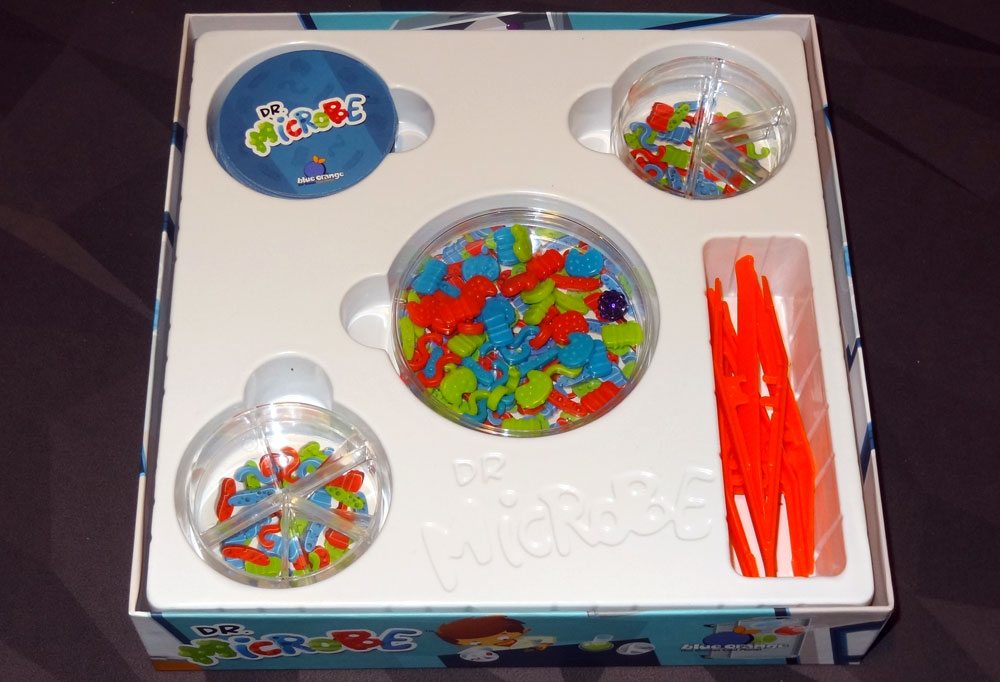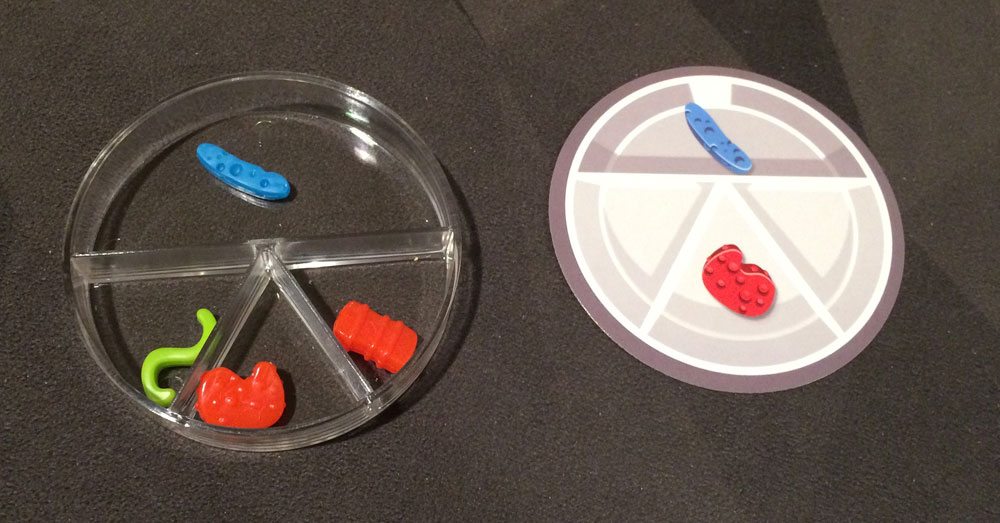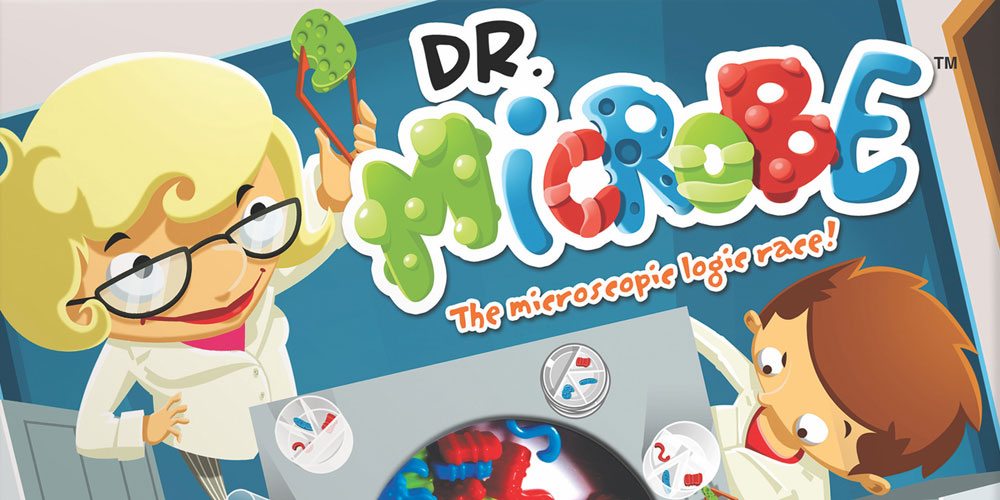Quick! Isolate the microbes and the superbug in your petri dish with your tweezers—but watch out for those other scientists, who are really just trying to sabotage your research so they can publish their dissertations first. At least, I presume that’s what’s going on in Dr. Microbe, a fast-paced puzzle dexterity game.
At a glance: Dr. Microbe is for 2 to 4 players, ages 8 and up, and takes about 15 minutes to play. It retails for 19.99 and is currently available in stores and online. The game requires some manual dexterity as well as a little bit of logic, and I think the age rating is about right—the game is good with both kids and adults playing together.

Components:
- 4 tweezers
- 4 small petri dishes
- 1 large petri dish
- 54 cards
- 48 microbes
- 1 virus
The components are pretty nice: the tweezers are large and pretty sturdy. The player petri dishes are small, with some dividers, and the large dish comes with a lid so that you can store the microbes in it.

The microbes themselves come in 4 different shapes, and three different colors (with 4 copies of each one), and they’re made of a hard rubber. The purple virus is a sparkly, bumpy ball and is made of a harder plastic.

The box for the game is a fairly standard large square box, but unlike Go Go Gelato!, there’s a lot of empty space in the box. It’s cute: there are microbe images tucked under the small petri dishes and on the cover of the instructions (under the big petri dish), and the large petri dish with the microbes shows through the transparent window of the cover, but the whole thing could probably fit in a much smaller box.
How to Play
The goal of the game is to score points by being first to complete the research cards, filling your petri dish with the right microbes. Officially, you play until somebody reaches 5 points, but really you can just keep playing until everyone agrees to stop, too.
Give each player a small petri dish and a pair of tweezers. Place all the microbes in the large petri dish, and shuffle the cards.

To play, turn over the top card of the deck, and then everyone races simultaneously to complete the card. You grab microbes from the petri dish with your tweezers and place them into your own dish.
Each card shows a number of microbes in the four sections of the petri dish. The three in the wedge-shaped sections are considered regular microbes, and then the other section holds the “superbug.” To complete a card, you must fill all four sections of your petri dish, but you’ll have to figure out the microbes that aren’t pictured on the card.

The microbes pictured on the card must be matched exactly, of course. The other rules are that the superbug must be a different shape and color from all of the other 3 microbes, and the 3 microbes must be different shapes from each other (but two will be the same color). So in the end, you must have all four shapes and all three colors, but the superbug must be a unique color. There may be multiple possible solutions to a card, depending on how many of the sections are filled in.

When you think you’ve got the solution, you shout “Eureka!” and everyone has to set their tweezers down while they check your solution. If you’re right, you get the card as a point.
Here’s one round of Dr. Microbe, filmed at GameStorm this year:
There are a few other rules in play, too, like immediately picking up microbes that you drop, and not stealing microbes from other player’s petri dishes. And, of course, you must use the tweezers and not your hands. (Some of those are superbugs, after all! Probably you should also be wearing protective eyewear and gloves, too.)
There are some variant rules as well:
- The Purple Virus: During play, you can pick up the virus and put it in the dish of the player to your left. You can’t solve a research card if the virus is in your dish.
- Sabotage: You may add microbes to your opponents’ dishes, though you still may not take anything from another player’s dish. Unwanted microbes must be placed back into the large petri dish.

The Verdict
Dr. Microbe is another puzzle-based dexterity game from Blue Orange Games, and pairs nicely with their other titles like Top That!, Dr. Eureka, and Go Go Gelato! However, this game is tipped a little more toward the puzzle-solving side and a little less toward dexterity. Sure, you still do have to be quick and nimble with those tweezers, but unlike the others you don’t have to worry as much about knocking something over or spilling things.
Instead, you have to think fast about which microbes to pick up, because instead of just matching a card, there are blanks to fill in. I liked this aspect of the game, because it changes the game from one of simple observation and matching to one that requires a small bit of logic and interpretation, all while your opponents are reaching for the same microbes that you are.
While there are enough microbes of each type to go around, when they’re all in a jumble it can sometimes be hard to spot the one you want, particularly with four sets of tweezers poking at the dish. Depending on whether you want to play nice or mean, the game can get really cutthroat as players fight over microbes or even snatch at another player’s tweezers to make them drop things—and that’s before you even throw in the purple virus or sabotage rules.

I generally introduce the game without the two variants first, but I’ve found that many players (especially adults) enjoy adding a bit of “take that” to the game. Being allowed to toss useless bits into somebody else’s petri dish may buy you just a little more time to puzzle out the research card while they’re cleaning up your mess—just like in a real lab, right? (Okay, hopefully not.) The hot-potato aspect of the purple virus is also a lot of fun, and the fact that it’s just slightly harder to pick up (and rolls farther if dropped) makes it particularly volatile.
While I don’t know if you really need all of the various dexterity games that Blue Orange has released, each one has a slightly different feel, and so it mostly depends on which sort of a challenge you think you and your kids will enjoy the most, or if one theme really jumps out at you. I like the balancing act of Go Go Gelato!, but I also like the logic puzzle of Dr. Microbe. They’re games that kids and adults can play together, and they’re a lot of raucous fun.
Disclosure: I received a review copy of this game.





